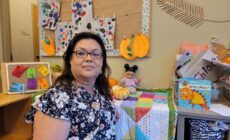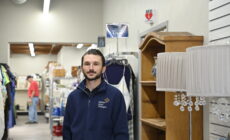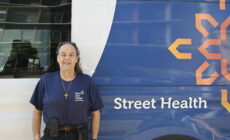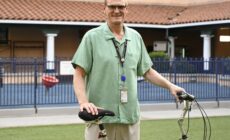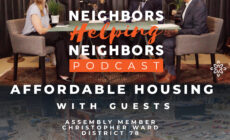Every morning, Megan and Jordan, members of Father Joe’s Villages’ Homeless Outreach Team, canvass the streets of downtown, East Village, Hillcrest and other areas looking to offer assistance to people experiencing homelessness. For those who want help, they offer them space in one of Father Joe’s Villages shelters. They also work to connect them with other resources such as meals, showers, medical care and more that will help them out of homeless and improve their quality of life.
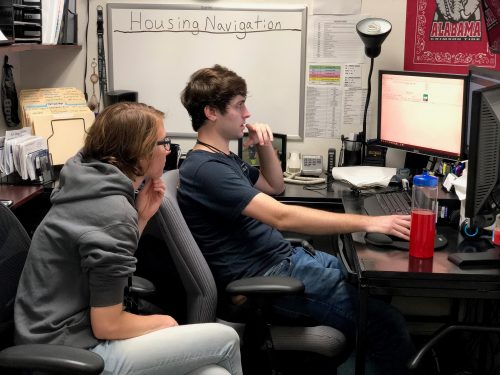
In their office, Megan and Jordan input information they received during their outreach walk into the Villages’ database.
Both Megan and Jordan have been working with Father Joe’s Villages for over a year.
Jordan knows firsthand what homelessness feels like. While battling with substance abuse issues, Jordan lived out of his car for 7 months in his hometown of Alabama until he finally decided it was time to get sober. That’s why, after moving to San Diego for a fresh start, Jordan applied to work on Father Joe’s Villages Homeless Outreach Team. He wanted to help individuals like himself come back from their lowest moments.
“I get what some of them are going through,” he says. “I understand how you feel like you can’t trust anyone, or how your addictions can run your life. I hope I can be proof that this isn’t the end of the world for them and that there is another side.”
Megan has also had her own experiences with homelessness. “My parents experienced homelessness and I lived part of that with them,” she explains. Sharing her own homeless experience helps her find common ground with the homeless individuals she works with on a daily basis.
We followed Jordan and Megan on one of their Homeless Outreach missions to get a better understanding of all they do for Father Joe’s Villages and our homeless neighbors living on the streets of San Diego.
What does the Father Joe’s Villages’ Outreach Team do?
Jordan: The Outreach Team helps manage intake at Father Joe’s Villages’ Bridge Shelter for families and single women. We have two lists we manage—one is a list of referrals from other agencies and the other is our own interest list—both with the names of individuals currently living on the streets who are looking for a bed. We work to fill the beds at the Bridge Shelter off those lists. If we can’t find someone on the lists to fill the beds, we then go out and speak with people currently living on the streets to see if they would like to be sheltered. We also go out with other organizations. On Thursdays, we do Coordinated Outreach with the San Diego Police Department’s Homeless Outreach Team. We’re Housing Navigators, too, so we have our own caseload where we meet with clients and work to get them housing.
Who can stay at Father Joe’s Villages’ Bridge Shelter?
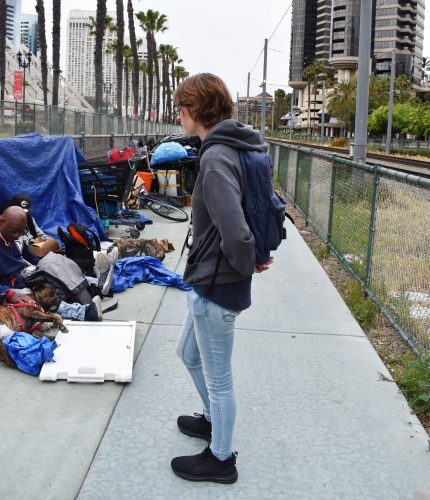
Downtown, Megan offers placement in Father Joe’s Villages Bridge Shelter to individuals living on the street.
Megan: Families and single women. Single men aren’t admitted into our Bridge Shelter. We still offer them the services by referring them to the San Diego Day Center and other Bridge Shelters. We also tell them about the other services Father Joe’s Villages offers like meals, job training and other housing. We refer them to other agencies we work closely with if we think they could possibly help them.
What is the process for a person living on the streets if they decide they would like to stay at the Bridge Shelter?
Jordan: They just have to sign up with us or at the San Diego Day Center and take a Prevention Diversion Assessment. The purpose of a Prevention Diversion Assessment is to try to help clients self-resolve their issues. We always offer them services first before we offer them a bed. We want them to exhaust all their options first—for instance if there is a family member who can help them or any benefits they can receive—before we put them into the region’s coordinated entry system and they go into a shelter. We want to really fix the issue of why these people are homeless instead of just putting a Band-Aid over it. We make sure we do everything we can before putting them into a shelter. After that, once a bed becomes available, we contact them, schedule them an intake time and the bunk is theirs.
What does a typical day on the job look like for an Outreach worker?
Megan: It depends on the day. Usually, the first thing we like to do in the morning is check the capacity for the Bridge Shelter, and document anyone who has checked out and why. At 10:00 am, we get the bed availability from Residential staff, and from there we’ll go back to our waiting list and try to contact anybody that is still looking for a bed. If we’ve exhausted that list, we go out on the streets and do Outreach for about three hours and try to pick up anyone who wants shelter. Certain days we do Coordinated Outreach with the HOT team, we do case conferences with the Regional Task Force on the Homeless for the clients already residing in the Bridge Shelter. That’s pretty much a typical day for us. Getting beds filled, doing Outreach, editing lists, and working as Housing Navigators to get clients housed.
Can you touch on the importance of building relationships with the homeless individuals you encounter?
Jordan: You definitely have to build a rapport with them to get anything accomplished. If you go about it in a strictly business type of way then people don’t want to open up and talk to you. The more trust you build with them the less they say “no,” and the more likely they are to say, “Well, ok, since you are saying that, I’ll give it a shot.”
Megan: We try to approach them in a friendly manner. They’ll talk to us about how their day has been and we really listen. I try to find some similarities. If a client has a cat, I can bring up my cat. We try to reassure them that we are not there to get them in trouble; we are honestly there to try to get them help.
Can you tell us about some of the stories you hear from people living on the streets?
Megan: There was one 77-year-old woman I spoke to who had been attacked multiple times while living on the streets and she had all her stuff stolen from her. So, of course, she was very untrusting and fearful. Most people will ask you for every little bit of information on the Bridge Shelter before they agree to anything. Some people refuse to sign paperwork because they don’t want to risk getting their identity stolen, and that’s because they have experienced that so much living out on the streets.
Jordan: A lot of homeless individuals don’t like things they aren’t familiar with. When you’re homeless and another person enduring homelessness tells you something is known to be ok, you’re more likely to believe them than if a stranger (who is obviously not homeless) asks if you want to go to some shelter. They really don’t trust “outsiders.”
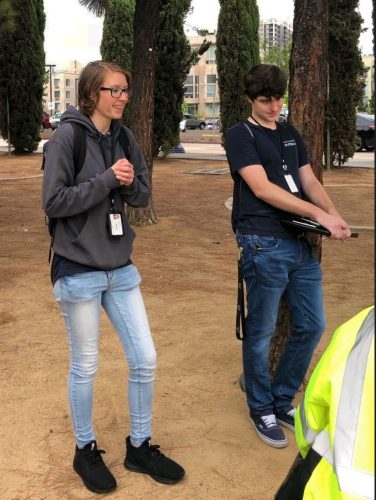
Megan and Jordan offer supportive services to homeless individuals living on the streets of downtown San Diego.
What do people experiencing homelessness need most?
Megan: Some just need income. There is a good majority of them that need mental health treatment assistance. It varies. Really, they need more low income housing options. The apartments out here are so expensive, and they require you to be making three times the cost of rent in order to be accepted for a place. None of these people can do that. That’s why a lot of them rely on subsidies to help them stay in their apartments. Without those subsidies, they would end up right back on the streets.
What do you want others to know about homelessness in San Diego?
Jordan: I always ask, how can we expect people not to be homeless when it costs so much to live here? It’s not getting any better. Rents keep increasing.
Megan: Also, so much is required to get approved for an apartment. Proof of former residency, rental history, an unreasonably high credit rating, two forms of identification, an income that is three times the rent. How do you think someone who was down on their luck and was living on the streets is going to be able to do all that?
What is your favorite part of being on the Outreach Team?
Megan: Catching up with these clients a year later and hearing how their life has improved. One client was so happy to tell me they were working two jobs and had an apartment now.
Jordan: That is the best. Two months ago these people were living on the streets with absolutely nothing, and now they are working two jobs and maintaining housing.
What is the best part about working for Father Joe’s Villages?
Megan: The best part of working at Father Joe’s Villages is developing relationships with clients and being able to see them succeed.
Jordan: Compared to other organizations, Father Joe’s Villages has so much to offer. We have housing programs, employment and education services, we offer free haircuts now, we have a medical clinic. We have more programs than any other agency working to help homeless individuals, and I am proud to be a part of that.
We Can All Make a Difference
Megan and Jordan are just another example of how Father Joe’s Villages helps our neighbors home. By assisting them off the streets and into shelter, Father Joe’s Villages’ Outreach Team brings our neighbors in need one step closer to permanent housing.
Join us in recognizing men, women and children experiencing homelessness as our neighbors in need by donating today.

